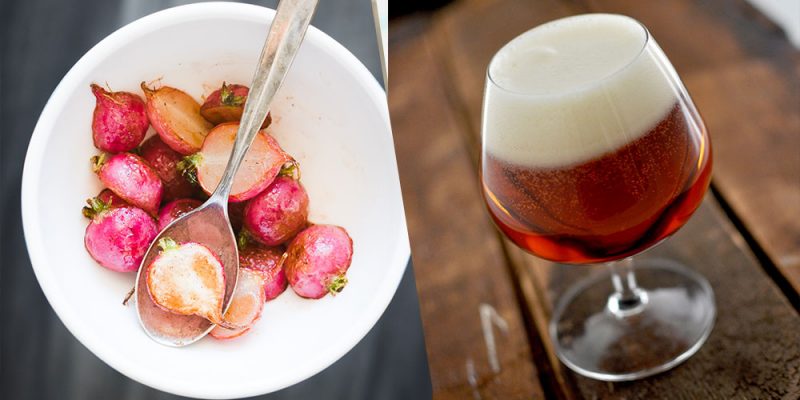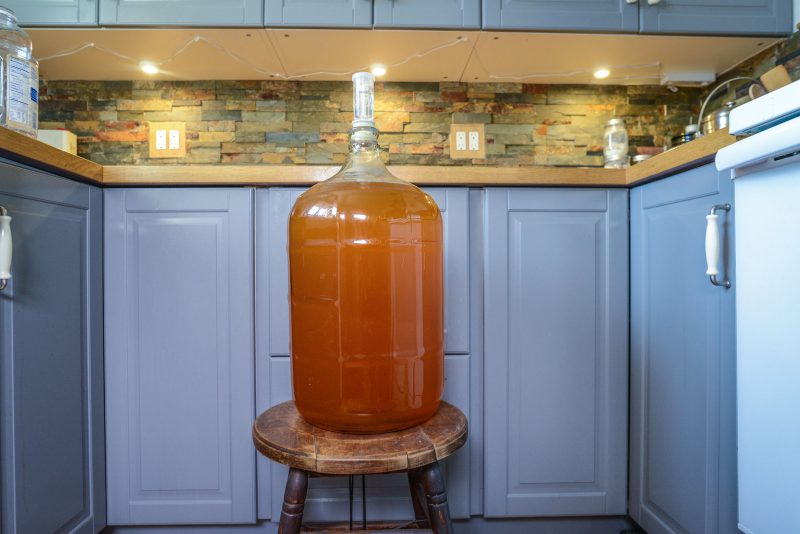
The Thanksgiving table is a complex place filled with diverse flavors that make it the immense feast that it is. It can be overwhelming to come up with a perfect pairing that melds together all the dynamic flavors of a meal, but according to Julia Herz, Craft Beer Program Director at the Brewers Association, a well-done Belgian tripel can handle all the aspects of the big dinner. The carbonation of this Belgian style can lighten the meal, while the higher alcohol level cuts and complements the many flavors that rest on your palate.
You can also select pairings for specific dishes in your Thanksgiving feast. We’ve pulled a few recipes for your Thanksgiving menu that you can try pairing with some of your stashed-away bottles of homebrew, or perhaps they’ll inspire you to brew one for next year’s feast.
Braised Radishes & Belgian Flanders

When people think about preparing radishes, the conventional thought process is that you’d dice it raw and throw it in a salad, garnish a dish for texture and a spicy zing, or pickle it for an acidic punch. Braising radishes, on the other hand, brings out an earthier and less bitter version of the root vegetable. Try pairing this side dish with a Belgian Flanders red ale. The complexity of flavors in the Flanders, particularly the higher-than-usual acidity and sweetness, helps bring out those underlying bitter and spicy flavors in radishes that brought you to choose them in the first place.
Ingredients:
- 3 bunches of radishes, quartered
- radish greens: destemmed, washed and cut
- 2–3 garlic cloves diced
- ½ white onion, finely diced
- chicken or vegetable broth
- salt
- pepper
- apple cider vinegar
- flat leaf parsley
Directions:
Step 1: Sautee onions and garlic in butter until the onions become translucent. Add a little bit of broth to simmer with the onions and garlic in the bottom of the pan and add the cubed radishes. The radishes should begin to turn slightly translucent as well. Allow radishes to simmer, add a splash of apple cider vinegar and a healthy shake or salt and ground pepper.
Step 3: Throw the washed and de-stemmed greens in at the last minute and stir until lightly wilted. Serve with fresh flat-leaf parsley for garnish.
Chèvre Mashed Potatoes & Blonde Ale

Everyone likes cheesy mashed potatoes, but adding a creamy chèvre to your taters adds a whole new dimension. The flavor profile of goat cheese is quite different from that of cow cheese, so unripened and unaged aspects of the chèvre really stand out when combined with the less complex potato. The malty sweet and bready aroma of a blonde ale would pair particularly well with the mild, lactic flavor that the goat cheese imparts in these potatoes.
Ingredients:
- 2 ½ lb. potatoes, quartered (Russets or Yukon golds with or without skin)
- ½–3/4 cup chicken or veggie stock
- 4 tablespoons butter, melted
- 1 oz. chèvre of your choice (I prefer an herbed chèvre, but plain or spiced chèvre will work just fine)
- 2 tablespoon salt
- ½ tablespoon pepper
Directions:
Step 1: Boil 1 gallon of water in a large pot with 1.5 tablespoons salt. Boil potatoes for 15–20 minutes until you can cut through them with ease. Drain the potatoes.
Step 2: While the potatoes are boiling, mix butter with chicken stock. Use more chicken stock if you want your potatoes creamy and use less if you’d like them thick.
Step 3: Once the potatoes are well cooked, mash them. I prefer to use an immersion blender to mash my potatoes, but if you don’t have one, a potato masher will work just fine. After the potatoes are initially mashed, begin adding the hot butter and stock to the potatoes and continue mashing. The potatoes should start to emulsify into a creamy texture, at which point you should add the chèvre. Add as much or a little as you see fit (it’s important to keep in mind that the dryness of the goat cheese can make your potatoes less creamy, so don’t overdo it, depending on your desired result: creamy or chunky?). If you can’t find herbed goat cheese at the store, I recommend adding in some ground thyme and rosemary, too. Add the salt and pepper, stir until the potatoes reach the desired texture, and enjoy.
Turkey Dry Rub & American Pale Ale

Some people brine their turkeys, but that takes some foresight, so try a dry rub instead. You still get loads of flavor and you’ll save a little time, too. The balance of malt and hops in an American pale ale is a great choice for a dry-rubbed turkey since the bitterness of the beer is just enough to cut fattiness in the poultry. An APA is also a great choice for cutting heat and enlivening the flavors of the spices in the rub.
Ingredients:
- 1 tablespoon paprika
- 1 tablespoon brown sugar
- 1 tablespoon chili powder
- ½ tablespoon onion powder
- ½ tablespoon garlic powder
- ½ tablespoon ground black pepper
- ½ tablespoon Aleppo chiles (or other flaked mild chile)
- 1 dash ground Himalayan sea salt
- dash cinnamon
- dash ground ginger
- dash cayenne
- 1 lemon
Directions:
Place the spices in a bowl and mix until well blended. Before applying the rub with your hands, mix olive oil and lemon together to coat the outside of the bird and help the rub stick.
Pumpkin Cake with Lavender-Cardamom Buttercream Icing & American IPA

This pumpkin cake with buttercream icing is nothing short of decadent. It’s also a great alternative to your standard pumpkin pie dessert you see at so many Thanksgiving dinners. So many flavors go into this recipe from floral notes in the lavender to spiciness in the nutmeg that selecting one beer to go with it could be a challenge. An American IPA would be an excellent pairing for this slice of heaven because the bitterness in the style balances out the fat in the creamy icing, plus the residual sweetness of the malt tones down the zing of sweet in the cream and sugar.
Frosting Ingredients:
- 4 cups confectioner’s sugar
- 1.5 tsp. vanilla extract
- ½ cup softened coconut oil
- 3 Tbsp. milk
- 8 Tbsp. softened butter
- zest of 1 orange
- 1 tsp. salt
- 1 tsp. ground cardamom
- 1.5 tbsp lavender sugar (If you can’t find this, feel free to just add lavender flowers as garnish)
- ½ cup lightly toasted pecans
Pumpkin Cake Ingredients:
- 2 cups all-purpose flour
- 1 ½ cups brown sugar
- 15 oz. pumpkin or winter squash puree (acorn, kabocha, butternut, jarrahdale, etc)
- 1 cup vegetable oil
- 3 eggs
- 2 Tbsp. cinnamon
- 1 Tbsp. lavender sugar
- ½ Tbsp. nutmeg
- ½ Tbsp. ginger
- 2 tsp. baking powder
- 1 tsp. baking soda
Frosting Directions:
Step 1: With an electric mixer, whip butter and coconut oil until creamy.
Step 2: Slowly add vanilla extract and confectioner’s sugar in 1-cup additions.
Step 3: Carefully add the milk based on how thick you want the frosting to be. Once you’ve reached the desired texture, add lavender sugar, salt, cardamom, and orange zest. Store in the refrigerator to thicken for a few hours and then apply to baked cake.
Pumpkin Cake Directions:
Step 1: Preheat oven to 425°F. Half squash and remove the seeds and stringy fibers. Put about ½ inch of water in Pyrex baking dish and place the squash face down, skin up. Roast the squash until soft enough to slice with a fork. Scoop all roasted squash out and discard the skin. Use an immersion blender or food processor to puree until smooth. I recommend doing this the day before you plan to make the cake.
Step 2: Preheat oven to 350°F. Grease a 9×13 inch baking pan (glass baking dish works, too) with butter.
Step 3: Place all dry ingredients (including spices) in a medium mixing bowl and stir until well blended. Set aside. In another medium-sized bowl, mix eggs, squash puree, vegetable oil, and vanilla extract together and set aside.
Step 4: Slowly add wet ingredients to dry ingredients and whisk together until smooth. Add the batter to greased baking pan and bake for 30–45 minutes depending on your oven. Let cake cool and apply lavender-cardamom buttercream icing. Lightly toast diced pecans in butter. Top the cake with lavender flowers and roasted pecans (optional).
* * *
Hailing from the South, Millie Shamburger has developed an affinity for the beer industry and all the shiny things that come with it. When not exploring beer, Millie is in the kitchen, enjoying the outdoors, & wearing out her dancing shoes.
The post Brew & Bites: 5 Thanksgiving Recipes & Beer Pairings appeared first on American Homebrewers Association.

![]()












